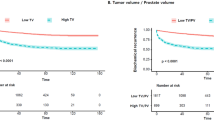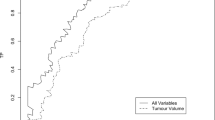Abstract
Prostate carcinomas located in the transition zone are suspected to behave differently from the more frequent peripheral zone cancers. In this study, large transition zone prostate cancers were investigated for pathological and clinical features. From 365 consecutive radical prostatectomy specimens, 73 cases were disclosed with tumours larger than 10 cm3. Of these, 14 were predominantly (>70% tumour area) located in the transition zone. Pathological investigations included a complete histological work-up, immunohistochemistry for p53 and bcl-2, and interphase cytogenetics for chromosomes 7, 8, 17, and X. Despite large tumour volumes and high preoperative prostate specific antigen (PSA)-values, most tumours showed quite favourable pathological features. Only two of these patients suffered from a postoperative PSA-recurrence during a median follow-up of 50 months. For comparison, 36 cases that contained tumours predominantly located in the peripheral zone mostly displayed adverse prognostic signs and 68.8% of these patients suffered from postoperative PSA-recurrence. We conclude that the peculiar pathological and clinical characteristics of large prostate cancers in the transition zone might be important for prognostic considerations.
This is a preview of subscription content, access via your institution
Access options
Subscribe to this journal
Receive 4 print issues and online access
$259.00 per year
only $64.75 per issue
Buy this article
- Purchase on Springer Link
- Instant access to full article PDF
Prices may be subject to local taxes which are calculated during checkout



Similar content being viewed by others
References
McNeal JE et al. Histologic differentiation, cancer volume, and pelvic lymph node metastasis in adenocarcinoma of the prostate Cancer 1990 66: 1225–1233
Stamey TA et al. Biological determinants of cancer progression in men with prostate cancer JAMA 1999 281: 1395–1400
Epstein JI, Carmichael M, Partin AW, Walsh PC . Is tumor volume an independent predictor of progression following radical prostatectomy? A multivariate analysis of 185 clinical stage B adenocarcinomas of the prostate with 5 years of follow-up J Urol 1993 149: 1478–1481
Stamey TA, Dietrick DD, Issa MM . Large, organ confined, impalpable transition zone prostate cancer: Association with metastatic levels of prostate specific antigen J Urol 1993 149: 510–515
Noguchi M, Stamey TA, McNeal JE, Yemoto CEM . An analysis of 148 consecutive transition zone cancers: Clinical and histological characteristics J Urol 2000 163: 1751–1755
Stamey TA et al. Prostate cancer is highly predictable: a prognostic equation based on all morphological variables in radical prostatectomy specimens J Urol 2000 163: 1155–1160
McNeal JE, Redwine EA, Freiha FS, Stamey TA . Zonal distribution of prostatic adenocarcinoma. Correlation with histologic pattern and direction of spread Am J Surg Pathol 1988 12: 897–906
Grossfeld GD et al. Locally recurrent prostate tumors following either radiation therapy or radical prostatectomy have changes in KI-67 labeling index, p53 and bcl-2 immunoreactivity J Urol 1998 159: 1437–1443
Stapleton AMF et al. Assessment of the biological markers p53, Ki-67, and apoptotic index as predictive indicators of prostate carcinoma recurrence after surgery Cancer 1998 82: 168–175
Henke R-P et al. Frequency and distribution of numerical chromosomal aberrations in prostatic cancer Hum Pathol 1994 25: 476–484
Qian J et al. Chromosomal anomalies in prostatic intraepithelial neoplasia and carcinoma detected by fluorescence in situ hybridization Cancer Res 1995 55: 5408–5414
Erbersdobler A, Hammerer P, Huland H, Henke R-P . Numerical chromosomal aberrations in transition-zone carcinomas of the prostate J Urol 1997 158: 1594–1598
Greene DR et al. A comparison of the morphological features of cancer arising in the transition zone and in the peripheral zone of the prostate J Urol 1991 146: 1069–1076
Grignon DJ, Sakr WA . Zonal origin of prostatic adenocarcinoma: Are there biologic differences between transition zone and peripheral zone adenocarcinomas of the prostate gland? J Cell Biochem 1994 19: 267–269
Bauer JJ et al. Elevated levels of apoptosis regulator proteins p53 and bcl-2 are independent prognostic biomarkers in surgically treated clinically localized prostate cancer J Urol 1996 156: 1511–1516
Häussler O et al. Cell proliferation, apoptosis, oncogene, and tumor suppressor gene status in adenosis with comparison to benign prostatic hyperplasia, prostatic intraepithelial neoplasia, and cancer Hum Pathol 1999 30: 1077–1086
Erbersdobler A et al. Allelic losses at 8p, 10q, 11p, 13q, 16q, l7p, and 18q in prostatic carcinomas: the impact of zonal location, Gleason grade, and tumour multifocality Prost Cancer Prostat Dis 1999 2: 204–210
Acknowledgements
This work was supported by a grant from the Deutsche Forschungsgemeinschaft to H Huland. The authors thank Cornelia Ebisch for technical assistance.
Author information
Authors and Affiliations
Corresponding author
Rights and permissions
About this article
Cite this article
Erbersdobler, A., Huhle, S., Palisaar, J. et al. Pathological and clinical characteristics of large prostate cancers predominantly located in the transition zone. Prostate Cancer Prostatic Dis 5, 279–284 (2002). https://doi.org/10.1038/sj.pcan.4500602
Received:
Revised:
Accepted:
Published:
Issue Date:
DOI: https://doi.org/10.1038/sj.pcan.4500602



